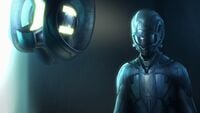Forerunner
From Halopedia, the Halo wiki
| Forerunner | |
|---|---|
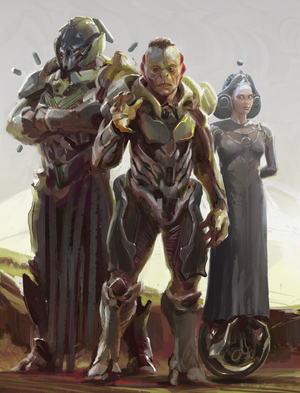 (From left to right) Faber, the Ur-Didact, and the Librarian | |
| Biological overview | |
|
Latin name: |
Primoris prognatus[1] |
|
Subspecies: |
|
|
Diet: |
Omnivorous |
| Physical information | |
|
Avg. height: |
198.1–414 cm (6 ft 6 in–13 ft 7 in)[2]
|
|
Avg. weight: |
|
|
Distinctions: |
Tall, humanoid, partially furred; various forms assumed by artificially-induced mutation |
|
Avg. lifespan: |
Thousands of years[1] |
| Sociocultural information | |
|
Homeworld: |
|
|
Tier 1[1] | |
|
Notable individuals: |
|
|
Also known as: |
|
|
Languages: |
|
- "We are Forerunners, guardians of all that exists. The roots of the galaxy have grown deep under our careful tending. Where there is life, the wisdom of our countless generations has saturated the soil. Our strength is a luminous sun towards which all intelligence blossoms, and the impervious shelter beneath which it has prospered."
- — The Ur-Didact, giving a speech on the purpose of the Mantle.
The Forerunners (Latin Primoris prognatus, meaning "Firstborn")[1] were an ancient species of extremely technologically advanced beings whose empire—known as the ecumene—encompassed three million fertile worlds in the Milky Way Galaxy.[3] The Forerunners reigned for millennia as the ascendant civilization in the galaxy until the activation of the Halo Array, their Pyrrhic solution to halt the Flood, in 97,445 BCE. Although they themselves are essentially extinct, evidence of their existence remained, spread across the galaxy in the form of numerous creations, installations and artifacts.
The Forerunners took upon themselves the role of caretakers of the galaxy, and believed that this "Mantle" had been passed down to them by the Precursors, an even more powerful race that preceded the Forerunner civilization.[4] "Forerunner" is a literal translation of the species' name for themselves; they identified themselves as such because they believed that they held an impermanent place in the universe's Living Time, though, in time, they too would be succeeded by other, superior races.[5] Before their disappearance from the galaxy, the Forerunners would name humanity their successors, identifying them with the title "Reclaimer".
In modern history, the alien hegemony known as the Covenant mythologized the Forerunners and revered them as gods, deriving much of their own technology from Forerunner artifacts found throughout the galaxy, and held that any who defaced these relics were heretics.
History[edit]
| “ | One hundred thousand years ago, the galaxy was populated by a great variety of beings. But one species—eons beyond all the others in both technology and knowledge—achieved dominance. They ruled in peace but met opposition with quick and brutal effectiveness. They were the Forerunners—the keepers of the Mantle, the next stage of life in the Universe's Living Time. And then they vanished. | ” |
Origins[edit]
- Main article: Forerunner-Precursor war
The Forerunners were created by the Precursors, a powerful race responsible for seeding the Milky Way Galaxy with life and creating many other species, fifteen million years ago.[1] The Forerunners were seeded on the planet Ghibalb in the Orion complex from a base stock that also produced humanity.[6] The world served as the hub of the Forerunners' fledgling interstellar civilization, comprised of twelve systems within the nebular complex, until it was rendered uninhabitable by an astroengineering disaster. The Forerunners had attempted to manipulate several stars in their region of space, but accidentally caused a series of supernovae that resulted in their planet being burned to a cinder by radiation. This event nearly caused the Forerunners' extinction.[7]
For ages, the Forerunners and humans evolved alongside each other with the Forerunners eventually overtaking their peers in wisdom and technological development. The Forerunners would master many arts and sciences at the feet of the Precursors, serving as their assistants and adjutants while the strange workings of their creators' minds and artifacts eluded even the Forerunners' keen intellects. As their interstellar civilization developed, the Forerunners came to believe they would be judged worthy to be the inheritors of the Precursors' Mantle of guardianship of all life. However, according to some records, over ten million years ago, the Forerunners achieved interstellar travel on their own and found remnants of their creators' existence long after the latter had left the galaxy to observe it from Path Kethona. During this time, the Forerunners discovered and claimed the Mantle as their own.[8] The Precursors did not approve of this and made the decision to strip the Forerunners of the Mantle, wipe out the Forerunners,[9] and pass down the Mantle to humans instead. Other records state that the Precursors originally chose humans to bear the Mantle without the Forerunners ever holding it beforehand.[6] Provoked either by this revelation alone,[10] or the Precursors' alleged decision to eradicate the Forerunners as a "problematic" species,[11] the Forerunners responded by overthrowing their creators, exterminating most of them in retaliation.[10]
The Forerunners, led by the then-dominant rate of Warriors, began their thorough campaign of extermination in the Milky Way galaxy and later chased the last Precursors down to the satellite galaxy of Path Kethona. There, they would finish their work, eradicating all but a few Precursors who managed to elude them. However, some Forerunners began to question the ethics of the genocide and refused to take part; many were summarily executed, while others were exiled on a barren planet in Path Kethona without any advanced technology. This population would survive for millions of years, preserving the knowledge of their origins in a biological reservoir of ancestral memory. However, they would remain as the last survivors of the fleet that traveled to Path Kethona, as those who had carried out the genocide until the end never returned to the Milky Way.[12][13][14]
Records of this war were gradually lost to time over millions of years, and Forerunner civilization as of the Forerunner-Flood war believed that the Precursors had simply disappeared after fulfilling their ultimate goal: creating the Forerunners to be their successors as holders of the Mantle.[15] For several millions of years after the annihilation of the Precursors, the truth was purposefully suppressed by those in power; there were some who attempted to uncover the true relationship between the Forerunners and the Precursors, but they were discreetly silenced, mainly by Warriors and Builders.[16]
Early history[edit]
Over the course of their history, the Forerunners established empires, fought wars, built worlds, and fought each other in a number of civil wars,[17] one of which took place over half a million years before their war against the Flood.[18] Their own various civilizations grew, splintered, merged and evolved until all eventually converged into the ecumene.[17] To safeguard the Orion complex—the center of the ecumene's governance—during these conflicts, the Forerunners constructed the Maginot Line, an immense array of defensive installations spread out in a sphere which completely surrounded the Orion complex. This defense was meant to repel any possible enemy incursion, but it eventually proved vulnerable against an unconventional attack.[18] During the civil wars, the Builder rate first rose to supremacy and initiated a cultural purge of the other rates, such as Warriors and Miners, which involved the suppression of their ancient rituals.[19]
The Forerunner civilization had cemented its place as the preeminent civilization in the galaxy by roughly 150,000 BCE,[20] around the same time humanity first began moving its latest interstellar civilization away from their homeworld, supposedly to escape early Forerunner control.[21] The Capital, the center of the Forerunner ecumene and the seat of the Ecumene Council, was constructed around 122,990 BCE.[22]
Over time, several rates were assimilated over time by the Builders which included the Interpreters, Historians, Weavers, and the Speakers.[23] The Forerunners fought a series of battles known as the Kradal conflicts in the galactic center[24] which were caused by the Didact's father, a descendant of the Interpreters, rallying millions of Forerunners began to believe that reparation was in order, calling for the restoration of the lost rates and bringing back the immense knowledge and rituals that had been confiscated and hidden away by the Builders. The Builders saw this movement as a threat, but couldn't silence him thanks to the Didact's mother and together, they united half of the occupied worlds to their cause, leading to the Kradal conflicts when the Didact was just a Manipular.
However, the Didact's parents lost the conflict and were executed with a special variant of the Suppressor which left nothing behind of them, not even an essence for the Domain. According to the Haruspis, to make reparations, satisfy the Ecumene Council and waylay any chance of revival, the Didact's parents and four others "volunteered" to pay the ultimate price as a cautionary tale - a lesson to those who might have had similar notions to shed light on the Builders' misdeeds. In reality, the Builders cornered them and held the lives of many, many others over their heads, including that of their son, to get them to agree.
As part of the punishment, the Didact, who was just a few domestic years beyond a decade at the time, had his memories of his early life erased and he was renamed Shadow-of-Sundered-Star, his true name and history left forgotten. The Didact would only know about this because the tale had been revealed to him in his later life by those seeking to cause the Didact pain and humiliation. However, the Didact had never wanted to believe that it was true. He was subsequently raised by Silence-in-the End who honed the Didact's skills while Bitterness-of-the-Vanquished oversaw his training, both of whom were present and prevented the young Didact from interfering in his parents' execution.[23]
War with ancient humanity[edit]
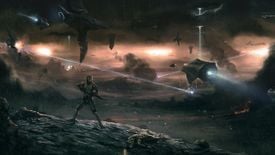
- Main article: Human-Forerunner war
Around 107,445 BCE, the Forerunners went to war with humanity's interstellar empire, in response to a perceived invasion of worlds where the Forerunners had relocated other species.[25] This invasion was thought to be caused by both human resentment at Forerunner expansionism during the previous fifty years and by the rapid growth of human populations.[26][27] After the war, a small number of Forerunners discovered the true cause of the invasion: a desperate human migration away from an extragalactic parasite known as the Flood. Desperate for new, uninfected worlds to replace the ones lost to the Flood, humanity invaded the worlds of other civilizations, bringing them into direct conflict with the Forerunners, who saw themselves as protectors of the Mantle.[28]
The Forerunners perceived humanity's actions to be a threat to the principles of the Mantle, and therefore waged a decisive war against humans, subjugating every human-controlled world and wiping them clean of all traces of human civilization. As punishment, humanity was stripped of its empire and technology and was exiled to its homeworld, Erde-Tyrene. There, humanity was devolved, splintered among its collective species and forced to begin anew.[25][29][30] The Flood, meanwhile, had been pushed beyond the edge of the galaxy, ostensibly by humanity's military efforts, and was not seen again for nearly nine millennia.[28]
Following the events of the war with humanity, a select group of Councilors and other elite Forerunners turned their attention to the possibility that the Flood would return. The Didact advocated a policy of watchfulness and military readiness, and proposed the construction of a series of shield worlds to provide quick military support should the Flood reappear. However, this plan was overruled by the council in favor of one put forward by a faction of Forerunner Builders led by Master Builder Faber-of-Will-and-Might, who proposed the construction of an array of galaxy-sterilizing superweapons as the ultimate defense against such a threat. These proposed weapons would be designed to starve the Flood to death by killing all sentient life in the galaxy with enough biomass to sustain them.[31]
The Council's acceptance of this plan caused the Librarian, a prominent Forerunner Lifeworker and the wife of the Didact, to speak out in condemnation of the Builders' proposal of mass genocide, and as a result, she and other Lifeworkers were permitted to work on the project as well, integrating their own measures for preserving the galaxy's life into the plan. The plan, the Conservation Measure, resulted in the Lifeworkers gaining biological preserves on the Builders' installations, including two Arks and a network of massive ring-shaped superweapons known collectively as the Halo Array. Meanwhile, the Didact and the other Prometheans who had supported his cause were removed from the council and executed or exiled. The entire Warrior-Servant rate was marginalized over the next thousand years, with their fleets and armies disbanded or merged into Builder Security, leaving the Forerunners ill-prepared when the Flood re-emerged.[32]
Forerunner-Flood war[edit]
- Main article: Forerunner-Flood war
Roughly nine thousand years after their war with the humans, a Forerunner survey team on the planet Seaward came into contact with the Flood. After this first contact, the Forerunners immediately recognized the great danger that the Flood posed to the entire galaxy and attempted to contain them. Even though they knew the power of the Flood, the principles of the Mantle forbade them from destroying it. As such, the attempt to contain the Flood was a failure, as they tried methods more suited to disease control instead of all-out warfare, trying to contain and quarantine the Flood rather than attack and destroy it outright. They did not start war until it was far too late.[33]
When the Forerunners were unable to contain the Flood outbreak, the galaxy entered a state of war. The Forerunners desperately studied the Flood, looking for any exploitable weakness. As the Forerunners soon realized that conventional naval tactics were ineffective against the parasite's onslaught, they developed new weapons and tactics to combat the Flood. The Sentinels were deployed as a means of maintaining the Flood through surgical, localized tactics. Eventually, the Forerunner fleet began to enact premature stellar collapse within compromised planetary systems, causing supernovae to engulf entire worlds.[34] However, these tactics proved only to slow, but never stop the expansion of the Flood. Even at this late hour, the Forerunners were reluctant to use the Halo Array, believing that they should continue to embrace the Mantle and to protect life rather than to destroy it. This led to great stretches of anguished debate and even civil war.[35]
Firing of the Halo Array[edit]
- Main article: Great Purification
- "After exhausting every other strategic option, my creators activated the rings. They and all additional sentient life within three radii of the galactic center, died, as planned."
- — 343 Guilty Spark on the fate of the Forerunners.
After nearly three centuries of war, what had been a relative stalemate quickly began to turn in the Flood's favor. The Gravemind managed to convince Mendicant Bias, the AI in charge of Forerunner defense, to unite with the Flood and turn its military assets against its creators. With the Flood growing at an exponential rate, entire themas of the ecumene were overrun; the Flood-infested regions, known as Burns, soon covered two-thirds of Forerunner space.[36] The Forerunners eventually resorted to the Maginot Line, leaving all systems beyond the Orion complex to fend for themselves.[18] Meanwhile, the Flood and the Graveminds developed into more capable and powerful forms, enabling them to tap into Precursor neural physics and control Precursor artifacts scattered across the galaxy. The Forerunners possessed no effective defense against these constructs and the Flood won most naval engagements as a result.[37]
After the Capital system was overwhelmed, the surviving leaders and population of the ecumene were relocated on the extragalactic installation known as the greater Ark, the original Ark used to manufacture the first Halo rings.[37] Aware that the Ark would not stay safe from the Flood for long, the Forerunner leadership realized that the only way to stop the parasite was to deprive it of all hosts by firing the Halo Array.[31] Soon after this decision, the Flood attacked the greater Ark and destroyed it. With most of the Forerunner leadership and population dead, the few surviving Forerunners, led by the IsoDidact, journeyed to Installation 00, the lesser Ark, its location still hidden from the Flood. The IsoDidact had the Halos distributed across the galaxy and activated the rings, killing all sentient life of sufficient biomass in the Milky Way, including any surviving Forerunners within the range of the Halo effect.[38] However, the Forerunner Lifeworkers had managed to save some of the galaxy's species by transporting them to the Ark during the Conservation Measure.[33][39] All neural structures within the Halos' range were destroyed; these included all Precursor artifacts, including the Domain, which the Forerunners had come to regard as the foundation of their culture.[40]
Exile[edit]
- Riser: "We will do what we can with what we are given. But what of you? Where will the Forerunners live?"
- IsoDidact: "I do not know, not yet. All I know for certain is that we cannot return to these places. We have already meddled too much in the affairs of others."
- — Riser and the IsoDidact as they bid farewell on a repopulated Earth.[41]
A number of Forerunners survived the firing of the Halo Array. Some managed to take refuge on Installation 00, safely out of the Array's range, while the Halo effect swept over the galaxy; most notably, this included the Lifeworkers assigned to installation and the IsoDidact. Based on limited information prior to the firing of the Halos, most of the other rates were believed to have perished on the greater Ark,[42] though a number of Warrior-Servants,[41] Builders, and Engineers were shown to be present later on,[43] indicating that more Forerunners survived to take shelter on the lesser Ark than previously predicted.
Around 97,368 BCE, the Forerunners discovered that the Xalanyn, a previously unknown species, had inexplicably survived the firing of the Halo rings. Realizing that their plan to pass the Mantle to humanity was in danger and that the Xalanyn were a threat to the rest of the still-recovering species on the Milky Way,[44] the Forerunners decided that the Xalanyn were to be imprisoned on Installation 07.[45]
After the remaining Forerunners had made sure that the Halos had done their work and the Flood had been eliminated, the species that were preserved on the Ark were returned to their home planets, a process lasting for over a century.[43] This was done by the remaining Forerunners under the leadership of the new Lifeshaper, Chant-to-Green, who received the title from the Librarian before the latter stranded herself on Earth at the endgame of the Flood war.[41]
Following the reseeding process, a group of surviving Forerunners led by the IsoDidact, now known by his original name of Bornstellar Makes Eternal Lasting, traveled to Maethrillian, the ecumene's former capital, in an effort to repair the Domain. While still mourning the loss of his wife, Bornstellar viewed a message wherein the Librarian revealed what she had learned from the Gravemind about the Domain's true nature and requested that he repair it. Within the capital, they were confronted by a Precursor construct known as Abaddon, who had been housed in the megastructure for millennia and now intended to bring the Forerunners to trial for their crimes. However, the Forerunners were successful in restoring the Domain with the sacrifice of Growth-Through-Trial-of-Change, undoing some of the damage the Halos had caused.[43]
The remaining Forerunners subsequently exiled themselves, as, according to Bornstellar, they were done meddling in the affairs of others.[41] This exile has also been referred to as a "Great Journey" by Bornstellar, who wished to bear the record of the Forerunner civilization's failures and their ultimate sacrifice for future generations.[33] The Forerunners left the Milky Way, journeying to another galaxy where they spread their numbers thin, with the plan of allowing their species to die out in time. At least Bornstellar and Chant-to-Green gave up advanced technology in favor of a simple, primitive lifestyle.[46]
Apart from the Forerunners sheltered on the Ark, the Ur-Didact also survived, having been imprisoned in a Cryptum in the shield world Requiem. While the Librarian was killed by the Halo pulse on Earth,[33][47] she left behind personality impressions of herself in various installations to guide humanity on the path she had intended for them. One such imprint existed in a Forerunner facility beneath Mount Kilimanjaro, while another was based on Requiem.[48] Several of these imprints would later consolidate at the Absolute Record.[49]
Legacy[edit]
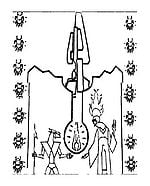
- "A god who creates tools is still a god. It is not for us to impose qualifications upon the divine or presume to guess its intentions."
- — Avu Med 'Telcam
After their disappearance, the Forerunners left behind a great deal of artifacts, many of the more significant ones overseen by their dedicated monitors which would react to outside visitors in accordance with their programmed instructions. The mystery surrounding the Forerunners and their technology would later become a source of worship, legend, advanced technology, or combination thereof for the various future civilizations which eventually stumbled upon some of the many Forerunner artifacts across the galaxy.[50]
The first known species to make use of reverse-engineered Forerunner technology were the Sangheili and San'Shyuum, having evolved on worlds rich in Forerunner artifacts. Regarding these artifacts and their creators with religious reverence, many wars broke out over whether the relics should be left in peace or used to advance their own technology.[51] Those who believed the latter came together to form the hegemony known as the Covenant, who together created a complex religion based around venerating the Forerunners as gods. Due to misinterpreting the ancients' records, the Covenant believed that the Forerunners disappeared from the galaxy after the Halo Array elevated their species to a state of trans-sentient godhood. As such, they appropriated many Forerunner technologies and artifacts, with the use of Luminaries that allowed them to track Forerunner-made objects all across the galaxy. The most holy of these artifacts, the "Sacred Rings" or Halo installations, were constantly searched for 1700 years, since the Covenant believed themselves to be the chosen inheritors of the Forerunners' legacy,[52] and by locating and activating the Halo Array, they believed that they too could follow the Forerunners into godhood.[53] This was referred to as the "Great Journey" by the Covenant races.[50][54] This mimicry of the Forerunners' remnants caused the Covenant to rise to a high technological tier very quickly, but additionally stunted their innovation of said technology and kept them from uncovering its true potentials.[55][56]
As for humanity, they had been chosen by the Forerunners to carry the title of "Reclaimer" and eventually take over the Mantle. The Librarian had imparted humanity with a species-wide geas;[57] these genetic instructions include an innate familiarity with Forerunner technology.[58][59][60][61] However, humans themselves were unaware of this and came into contact with Forerunner artifacts relatively late in their history, after they had colonized many planets. In 2491, a collective of human artificial intelligences uncovered the presence of Forerunner relics on Onyx and kept them hidden in the meantime for fear that humanity was not yet ready to use such advanced technology. As such, archaeological excavations did not uncover them until 2511, and the United Nations Space Command's Office of Naval Intelligence responded by hiding the planet's location and securing the area. However, little progress was made in translating any of the relics.[62] Other relics were discovered on Reach, Earth, and many other colonies. A Reach titanium mine had been shut down when they breached a Forerunner complex, and SWORD and CASTLE Base were built to guard relics' locations.[63] The Excession was buried under New Mombasa and undiscovered until much later, prompting ONI to construct a major facility to study and cover up the structure from the general population.[64] Mixed reactions came from scientists who studied the artifacts, some fascinated by their potential, others fearful for the possibility of a two-front war.[65]
Artifact involvement[edit]
- "Mankind is outmatched. When Reach falls - and it will fall - our annihilation is all but certain. Unless...we can glean from this artifact a defense against the Covenant. A game-changer. On the level of the conical bullet in the nineteenth century, or faster-than-light travel in the twenty-third."
- — Dr. Catherine Halsey, after decrypting the Forerunner artifact under SWORD Base.
Forerunner artifacts became instrumental to beginning and ending the Human-Covenant War. First contact was made when humanity's Reclaimer status was discovered by the Covenant, who did not understand that they were being labeled as Forerunner objects. The Hierarchs of the Covenant soon learned humanity's status as apparently living descendants of their supposed gods, and found it potentially destructive to their religion. Thus they decided to hide this information from the general population and ordered that humanity be eradicated, a goal in which they nearly succeeded.[50] Battles were fought often with relics at the center of the conflict, sometimes risking giving the Covenant victory early, other times hindering them and turning in favor of humans due to the Covenant's reluctance to damage Forerunner treasures. Many relics were destroyed by humans often as traps for Covenant or to keep them from falling into enemy hands.[66][67][68]
The most important of Forerunner artifacts to be involved was the Halo Array, the first ring of which was discovered on the heels of the destructive Fall of Reach.[69] The resulting Battle of Installation 04 revealed to humanity the existence of the Forerunners and their sacred place in the Covenant's religion, as well as the rings' true purpose as weapons of mass destruction. The activation of the Halos led to the awakening of other Forerunner relics, such as the Sentinels of Onyx, or the Ark that controlled the Halo Array. Humanity's utilization of Forerunner tech was thus regarded as a "game-changer" to turn battles into their favor[70] and also changed the goal of the war, now to keep the Covenant from reactivating the Array in their misguided pursuit of apotheosis. As the conflict drew to a close, the Covenant had been plunged into civil war as some discovered the Great Journey was false and thus allied with humanity.[71] The final battle of the war was fought aboard the Forerunners' Ark, and the UNSC and Covenant separatist forces together secured the Halo Array, destroying the Ark shortly afterward. In the post-war years humanity was beginning to reclaim its appointed place, gaining many technological leaps as a result of acquiring and reverse-engineering Forerunner technology with the assistance of a number of Huragok they had managed to procure.[72]
Return[edit]
- "Time was your ally, human, but now it has abandoned you. The Forerunners... have returned."
- — The Ur-Didact to John-117, after being awakened in the interior of Requiem.
The years following the end of the Human-Covenant War saw the revival of a Forerunner presence in the galaxy, with the reawakening of the Ur-Didact, once the supreme commander of the Forerunner Warrior-Servants. A zealous Forerunner supremacist with a renegade hatred for humans, the Ur-Didact sought to use a machine known as the Composer to convert all of humanity into subservient war machines near the end of the Forerunners' war with the Flood. To prevent this, the Librarian imprisoned the Didact in a Cryptum on the shield world Requiem, where he remained for the next 100,000 years.
In July 2557, the Ur-Didact and his mechanized Promethean forces were accidentally awakened by Spartan John-117 who had stumbled upon Requiem. His views unchanged by his long exile, the Didact disregarded humanity's Reclaimer status and maintained his belief that only the Forerunners were worthy of the Mantle. The Didact and his Prometheans, allied with a new Covenant faction, went to war against humanity, aiming to prevent them from attaining the Mantle. Attempting to use the Composer to digitize humanity, the Didact attacked Earth. However, the Master Chief and his AI Cortana stopped and defeated the hateful Forerunner, casting him into a slipspace portal, and subsequently destroying the Composer and the Didact's ship. They were aided in this by the Librarian, who had left an imprint of her memories behind on Requiem. The Librarian's essence augmented the Master Chief's genetic code in order to allow him to face the Didact, giving him, along with other things, an immunity to the Composer that saved his life. However, the Didact survived his fall into slipspace and intended to finish what he started. While the Didact was eventually "contained" as a threat by the Master Chief and his squad-mates,[73] the Promethean-Covenant alliance was not defeated by this setback and the conflict was still in progress in early 2558 when the UNSC Infinity returned to Requiem. After a lengthy campaign, Requiem was destroyed by the Covenant leader Jul 'Mdama, along with all Promethean constructs present on the shield world.[74]
At some point after the Didact's attack on Earth, Cortana learned about the existence of Keeper-of-Tools, a Forerunner Builder alive on Genesis and went after him, but the Builder managed to escape from her. Thanks to the efforts of Rion Forge and Spark, Keeper-of-Tools would reach Bastion, the Librarian's hidden shield world, and launch the Eden starship with Precursor specimens, to reseed them in another galaxy.[75]
Following his defeat on Installation 03, the Didact's digitized consciousness was uploaded to the outer boundaries of the Domain.[76] where he discovered that nearly all of those Forerunners who died in Halo's wake were shut out of the Domain and trapped in the outer boundaries along with the essences of the Ancestors who had been digitized as well as those who fell victim to the Composer in New Phoenix.[77][78] Freed of the Gravemind's corruption by the Composer's power,[79] the Didact regained his sanity and set out to free the Domain from Cortana's influence, ultimately destroying the Warden Eternal,[80] welcoming millions of Forerunner and human essences into the repository, evicting the Created, and sealing it off from the physical world so that none could ever misuse the Domain again as Cortana had. At last at peace, the Didact reunited with his wife in the Domain to spend eternity together.[81][82]
Physiology[edit]
The Forerunners were a bipedal species resembling humans in overall shape, though they were larger in stature. Over the course of their lives, Forerunners underwent a number of artificially-induced mutations, modifying their bodies to better suit the field of work of their rate. More specific aspects of their appearance varied with lineage, age and even personal tastes.[1] They relied heavily on personal body-assist armor which, in addition to protecting the wearer from harm, augmented their physiology and mental faculties. Among many other advantages, it made their lifespans virtually indefinite by providing constant life support and medical care.[83][Note 1]
Before their first mutation, as Manipulars, Forerunners were tall and slender, and possessed patches of fine, purple-pink or white fur on the top of their heads, along their nape and shoulder area, as well as the backs of their hands.[84] Their facial features were similar to those of humanity, and they were capable of making analogous expressions, but this changed as they mutated to their higher forms, which characteristically had stiffer facial muscles and a more limited ability to convey emotions.[85] There was also a cultural stigma associated with expressing emotions; while even certain higher forms were capable of producing some semblance of a smile or laughter, for example, such uncontrolled display of emotions was regarded as barbaric.[86] Unlike humans, Forerunners lacked pronounced noses or ears, having two slited nostrils and a set of bulbous protrusions instead.[74] Their skulls otherwise bore a very strong resemblance to those of humans, with subtle differences. The Forerunners also had a genetic code that was remarkably similar to humans, though they were not known to be genetically related.[87] However the defunct Theoretical rate of the Forerunners own studies of human and Forerunner origins concluded that humanity share a genetic structure homogeneous to the Forerunners.[88]
The Forerunners exhibited sexual dimorphism largely mirroring that of humans, with the females being more slender and somewhat smaller in stature than the males. The height of higher-form males ranged from around three to four meters; for example, the Ur-Didact was three and a half meters tall,[89] while Wise-Hands-to-Forge, a high-ranking Builder, was around four meters. His wife, a female Builder of the same social standing, was just over two meters in height,[90] while the Librarian, head of the Lifeworker rate, was nearly three meters tall.[91] Males of higher forms also bore less resemblance to humans, while the females appear to have been more human-like in appearance.[84] A large portion of this dimorphism was artificially induced with their mutations and determined by rate.[92]

Their skin color ranged greatly, including gray, black, blue, pink, or a mixture thereof. The number of fingers Forerunners possessed varied according to their rate and form; the most common number of fingers per hand appears to have been six, with two opposable thumbs,[93][94] although some Lifeworkers could have as many as seven fingers per hand.[95] Meanwhile, the Librarian had only five fingers in each hand,[74] although this was a deviation from the norm.[92]
Thanks to their advanced life-support and medical technology, Forerunners could maintain a youthful appearance for thousands of years should they so choose.[96] Even though Forerunner armor was capable of healing most injuries which would otherwise be certainly lethal, including fatal doses of radiation,[97] on rare occasions Forerunner individuals may choose to decline basic treatment; the ancient Warrior-Servant known as Bitterness-of-the-Vanquished, for example, chose to remain blind and instead relied on her armor to provide sensory input for her.[98]
While the Forerunners had a biological need to sleep, this necessity was eliminated by the use of personal armor which allowed them a constant continuity of consciousness without having to sleep;[99] only on rare cases, they would experience diagnostic waking dreams.[100] As such, Forerunners slept very rarely, mostly doing so by choice in instances such as long stretches of space travel, which themselves were rare due to their exceedingly fast slipspace technology.[101]
Forerunners possessed highly advanced mental capabilities, far beyond those of a human in the case of their higher forms. These abilities were further augmented by their use of personal armor, which integrated with the wearer neurally and stored sensory information and memories, even consistently backing up the wearer's consciousness.[102] The armor also allowed Forerunners direct information transfer to one another,[103] which could also be employed in the form of "silent conversation".[104] Higher-form Forerunners had the ability to process enormous amounts of information simultaneously; for example, Warrior-Servant commanders could simultaneously process the sensory input of thousands of their subordinates while coordinating large-scale battles and themselves experiencing reality in multiple separate frames of reference with variable streams of time.[105][106] The use of an ancilla enabled Forerunners to recall any past event with exact accuracy[107] and even without armor or a personal ancilla they could remember enormous amounts of precise information; for example, the Didact was able to recite a verbal control code consisting of hundreds of completely random words and numbers after thousands of years.[108]
Mutation[edit]
- Main article: Forerunner mutation
When a Manipular was ready to work within a particular rate, they would undergo an artificially-induced transformation into a more advanced form, which differed depending on the Manipular's chosen caste. Referred to as a "mutation", the transition typically occurred over a long period of time.[109] A typical Forerunner would undergo several mutations over the course of a lifetime, though this was not always the case. Mutations altered Forerunners' abilities and physical shape to suit their class; Warrior-Servants, for example, underwent mutations that made them stronger and more robust. After their first mutation, Forerunners also gained the ability to access the Domain, a realm of information where the entire collated knowledge of the Forerunner civilization was contained.[110]
In emergency circumstances, an operation known as a "brevet mutation" could be performed on a Manipular. This was a mutation that occurred over a much briefer period of time, and was often painful. Rarely, a brevet mutation could fail and result in deformities; there were rumors that Forerunners whose mutations had failed were sequestered in special enclaves, hidden from the general population.[111] The Ur-Didact performed a brevet mutation on Bornstellar Makes Eternal Lasting to give him access to the Domain.[112]
Society and culture[edit]
The Forerunner civilization was based around the Mantle of Responsibility, a belief that it was their role to protect all life in the galaxy; it was generally believed that the Forerunners had gained the Mantle as a birthright from the Precursors after they vanished. As a result of their perceived status as universal guardians, the Forerunners largely secluded themselves above other species.[113] They monitored the evolution of other sentient species throughout the galaxy, intervening in ways that ensured their civilizations would follow paths of peace, free of conflict, but also so that they would not challenge Forerunner dominance. To maintain their position, the Forerunners committed acts such as relocating other species from their homeworlds in order to expand their own empire or gain control of new resources. They also enforced the Mantle by hindering the development of other species, even reducing opposing species to small populations of specimens, as they did with early humanity.[114] Those species who submitted to Forerunner rule lived within the ecumene as subject species, allied with but ultimately subservient to the Forerunners; some of these species helped eliminate pockets of human resistance after the human-Forerunner wars.[115]
The Forerunners themselves were a race almost entirely without conflict; although political disputes were not uncommon, violence or war between Forerunners was almost unheard of, the last Forerunner civil wars having been fought half a million years before their civilization's end.[18] As such, the Warrior-Servants, who conducted most of the Forerunners' military operations, were often looked down upon by the higher rates, as their actions were perceived to be contradictory to the Forerunners' role of preserving life. While they generally strove for peace, when provoked to a war, the Warrior-Servants would carry out the war ruthlessly and thoroughly, as they believed defiance of their rule was equal to showing contempt to the Mantle itself.[116] One example is the human-Forerunner wars, where many humans were executed following their defeat, and all traces of human achievement was erased from the galaxy.
Forerunner culture was highly stagnant; the fundamental aspects of their society—such as their rate-based social hierarchy—remained unchanged for millions of years.[117] The Forerunners had a rigid social structure, where one's position would be determined mainly by their rate, part of a complex system of different social classes mainly based around a particular occupation. Cultural practices and customs varied by rate and position; generally, Forerunner culture was full of formality and ritual, particularly with the Builders, the highest of the rates. Forerunners placed a great deal of value on family lineage and tradition, and one's rate and social standing were largely hereditary.[118] When Growth-Through-Trial-of-Change, born to a Builder family, chose to become a Lifeworker instead, she was treated as an outcast by her family.[41]
A central aspect of Forerunner culture was the Domain, a vast repository of information containing virtually all knowledge collated by the Forerunners over the eons, including impressions of the deceased,[119] leading the Forerunners to also view the Domain as a form of afterlife.[120] Although the Domain permeated Forerunner society for countless millennia, its origin or true nature remained mysterious to the Forerunners themselves. The Domain was best understood by the monastic class of Haruspices, who dedicated their lives to the study of the Domain.[121] While unknown to the Forerunners, the Domain was actually a neural physics-based Precursor construct, and as such was destroyed when the Halos fired, taking most of the Forerunners' recorded history and knowledge with it.[40] When Halo's destructive pulse was fired, the Domain suffered extensive damage and went silent. The pulse blew through the Domain's quantum expanse, destroying billions of years worth of information and much of the delicate neural lace that entwined everything together. Many things happened in that instant, including the void being forced into existence, nearly all of those Forerunners who died in Halo's wake were shut out, and every Haruspis inside and outside of the Domain was annihilated. The Domain became like a wounded animal, throwing out the only meager defenses that it had to protect itself which included the void that acted as an inexhaustible quantum barrier.[122] It wasn't until the Didact destroyed the Warden Eternal 100,000 years later that the Forerunners were able to enter it again and reside in the Domain alongside the digitized Ancestors and the victims of the New Phoenix Incident.[80][81]
Despite their lack of need to sleep as a result of the use of personal armor, Forerunners had certain moments where each member of a household would retreat for several hours of individual meditation. These moments were typically arranged according to the local day-night cycle, and were sacrosanct in traditional Builder families. During this time, the activities on an entire planet would slow down, including traffic and even the operations of ancillas.[99]
Forerunners did not eat meat, as the Forerunners' scripture surrounding the Mantle forbade "the eating of the flesh of unfortunates".[123] Taking one's own life was also gravely forbidden.[124] Despite their in many ways conservative society, nudity or sexuality were not considered taboos in Forerunner culture; for example, it was normal for both participants to be naked during the rite of mutation, without the procedure being considered explicitly sexual.[125]
Some Forerunners rejected their advanced technology, including personal armor, and adopted a more austere and primitive lifestyle in seclusion from the rest of Forerunner society. One such community existed on Seaward, which would incidentally become the first planet in the Forerunner ecumene to be overrun by the Flood.[126]
Government and politics[edit]
The Forerunners' primary governing body was known as the Ecumene Council. Based in the capital, it was led by the First Councilor and composed of five hundred Councilors, in addition to support by a network of ancillas known as the Council metarchy.[127] The Councilors, who came from various rates, typically served for a thousand years and led humble lifestyles.[128] The capital also housed the ecumene's primary judicial institution, known as the Capital Court, which could be assembled into the Supreme Mantle Court in times of great crisis.[129]
Societal classes[edit]
- Main article: Rate
Forerunner society was divided into a number of different classes known as rates, each rate specializing in a particular field of work. The Builders, who designed most Forerunner technology, from ships and weapons to their various megastructures, were the highest rate and wielded the most political power. The second rate were the Miners, who obtained construction materials for the Builders' projects and were responsible for planetary and stellar engineering. Below the Miners were the Lifeworkers, who were responsible for medicine and biological research. The Juridicals were a rate whose duties encompassed legal matters within the ecumene. The Warrior-Servants served as the primary fighting force of the ecumene, while the Engineers maintained technology and machinery.[130]
There were many other rates who were assimilated by the Builders in their rise to power. Millions of years worth of history, wealth, culture, knowledge and ritual were forcibly absorbed by the Builders who accomplished this through the consistent erosion of the rates' contributions to society through corruption, and via campaigns of misinformation. These rates included the Interpreters, the Weavers, the Speakers, and the Historians.[23]
The rates, in turn, were divided into smaller units, guilds, Maniples and clans. Adolescent individuals, known as Manipulars, were not considered to be part of a rate until their mutation into first-form. During special occasions, each rate of Forerunners wore unique ceremonial headgear except for one day of Grand Star Season, when all rates would wear similar headgear.[131]
Family and marriage[edit]
Forerunner customs involving marriage were said to be complex; they married for a variety of reasons, though it was said that the lower rates married more often for love,[132] while there were often more complex reasons such as familial relations involved in the courtship of higher rates such as Builders.[109] Intermarriage between rates was not unheard of; for example, the Didact, a Warrior-Servant, married the Librarian, a Lifeworker. Additionally, a certain degree of courtship between rates was considered commonplace before individuals were espoused to formal marriage.[133] Polygamy was also an accepted practice, at least among the higher rates, as demonstrated by Master Builder Faber having many wives.[134] At certain points in their lives, females would enter a "millennial interim", a period when they would not bear children.[135]
Languages and scripts[edit]

Forerunners spoke a variety of languages. Some dialects were older than others, and accordingly were less widely used. Digon was an ancient language used by Prometheans, while Jagon was a slightly less old language used by Builders.[136]
The most commonly encountered system of Forerunner glyphs seems to be based on a series of circular, complex shapes. The glyphs have been inscribed almost everywhere Forerunners were once present, from different areas of Earth, to the Halos. They were also known to put these glyphs and symbols onto their weapons, machinery and clothing, something the Covenant also copied, evident with the Forerunner symbols placed on the hilt of the energy sword and on the Sangheili combat harness. Among the most well-known glyphs are the "Mantle" and "Reclaimer" symbols, as well as the sigils of individual Forerunners.[74] Some variations of Forerunner symbology possess a strangely attractive, even disorienting quality to humans.[137]
In addition to the well-known symbols and glyphs, the Forerunners also utilized a more conventional writing system. The characters used in Forerunner writing have been described as resembling a series of dots, squares, bars and triangles. The Covenant writing system is derived from the original Forerunner script, although they use highly embellished variations of the simple, geometric characters used by the Forerunners.[138]
Naming conventions[edit]
Forerunner names had concrete meanings in their language, and commonly consisted of a combination of words expressing positive attributes in a grandiose, somewhat poetic manner. In many cases, a Forerunner's name was associated with typical terminology involved with the practices of the rate they were born into; for example, "Bornstellar-Makes-Eternal-Lasting" reflects his Builder lineage. In informal conversation, these names were typically shortened, with only a single part being used.[139][Note 2]
Many, though not all, higher-ranked or older Forerunners were only known by a title not given at birth but rather adopted at one point in the Forerunner's life, often originating as a sobriquet given to that individual due to one of their traits; for example, the Didact, who was stripped of his original name at a young age and renamed[23] Shadow-of-Sundered-Star,[89] gained the name "Didact" from his students while teaching in the War College.[140] Manipulars were identified as "Form Zero" in their full names.[141]
Funerary rites[edit]
When a Forerunner died (usually by accident or, on rare occasions, during war) elaborate ceremonies would be enacted before their remains were disposed of in fusion fires associated with the activities of their rates — a melting torch or planet cutter, for example.[83]
First, the Forerunner's last memories would be extracted from their armor, which preserved a few hours of the occupant's mental patterns. This reduced splinter of personality would be placed in a time-locked Durance with a half-life of more than a million years. The body would then be torched in a solemn ceremony attended only by close relations. A bit of plasma from the immolation was preserved by the appointed Master of the Mantle, who secured it along with the essence in the Durance. The Durance was then given to the closest members of the dead Forerunner's family, who were charged with making sure that it would never be abused. Families and rates were very protective of such places, and tampering with a family Durance was considered sacrilege.[83]
Space travel[edit]
Traditionally, Forerunner space travel involved several rituals. When a Builder family was returning from an interstellar journey, the entire family would stand at the bridge deck and observe the ship's approach. The senior family member would issue commands in ancient Jagon. These actions were entirely ceremonial, as nearly all Forerunner ships were controlled by an ancilla.[136]
After making a slipspace jump, Forerunners of high position, including Councilors, would conduct a ceremony where they formally congratulated the ship's ancilla and would in turn receive a small golden disk containing the cost of particle reconciliation for the journey.[142]
During prolonged space journeys, Forerunners would often play "diverting games" through their armor to pass the time.[143]
Technology[edit]
The Forerunners' technological achievements were almost without parallel in the known galaxy with them being rivaled by ancient humanity and the San'Shyuum before the latter two species defeat in the human-Forerunner wars and with only the Precursors being known to surpass the Foreunners technologically. They managed to create solidified surfaces out of light by using technology known as hard light, use slipspace to teleport between locations almost instantaneously, and create numerous forms of advanced machinery. Another of their greatest achievements is their ability to initiate premature stellar collapses of stars and create planets in less than 10,000 years. The Halo Array and the shield worlds are, above all others, the most significant pieces of surviving Forerunner technology. The planet Onyx and its inner Dyson sphere, Shield World 006, in particular demonstrated both their ability for engineering on a grand scale, and their near-transcendent grasp of slipspace technology. Forerunner technology is remarkably resilient, being able to remain intact for over a hundred millennia.[144]
Even after millions of years, Forerunner technology still advanced at a comparatively rapid rate, with a number of new breakthroughs and developments occurring within even a single millennium.[145] It was believed by some Builders that the Forerunners had possessed more advanced technologies in their distant past that they had later lost during periods of technological regression. This was at least partially true, as demonstrated by ten-million-year-old Forerunner probability mirrors, used for large-scale spacetime reconciliation, and similarly ancient cloaking technology used to obfuscate the interior of an entire star system in the Large Magellanic Cloud.[146]
They employed a wide variety of artificial intelligence constructs, generally known to them as ancillas. These ranged from simple personal assistants integrated in their armors to various kinds of robotic Monitors and immensely powerful Metarch-level AIs, of which the most sophisticated type was the Contender-class.[33]
The Forerunners had mastered the use of various energy fields, including buffer fields which they used to manipulate gravity,[147] constraint fields used to restrain individuals, confinement fields used to block the movement of entire ships, and the containment and collection fields they used to harness entire stars for energy production.[148] Entire planets could be made habitable even in conditions of lethal stellar radiation via planetary shields.[149]
The Forerunners had an unparalleled knowledge of quantum science, which enabled them much of their sophisticated technology.[150] After a number of instances of catastrophic data loss in their history, they had abandoned conventional digital storage in binary code entirely in favor of storing information in substrates of quantum foam.[151] Virtually all Forerunner technology was powered by harnessing and draining the energies of untold numbers of nascent alternate realities in the form of vacuum energy.[152] This enabled the Forerunners to harness enormous amounts of energy, with a single slipspace-based transmission noted as requiring more energy than the generation capacity of all UNSC assets combined.[153]
In addition to their superior grasp of slipspace travel, the Forerunners had mastered many other methods of higher-dimensional manipulation. They were capable of altering the fabric of time and space within contained "bubbles" of slipspace, allowing the storage of enormous masses and volumes within a comparatively tiny space; as an extreme example, the 300-million-kilometer Shield World 006 was held in a space only 23 centimeters in diameter in normal space. In these bubbles, the flow of time could be suspended altogether, or numerous millennia could be made to transpire while only seconds had passed in normal space.[154] The Forerunners routinely employed the higher dimensions of slipspace in their fleet engagements and created defenses which extended into slipspace,[155] most prominently the Maginot Line.[156]
Forerunner technology could also produce certain objects remarkably quickly without extensive production facilities. For example, personal armor could be manufactured by small engineering units on board a starship,[157] and entire ships could be "grown" from a "design seed", being manufactured on-site from preprogrammed "blueprints" and construction materials obtained from local resources. Likewise, certain automatons — such as Promethean Crawlers — could be "conjured" on-site and constructed in a matter of seconds from raw materials present in the ground.[74] Most Forerunner technology could disassemble and reconfigure itself into a completely different form, and automatically gather any additional construction materials if necessary; this was demonstrated when the Librarian had a Gargantua-class transport use both itself and resources mined locally to construct the Excession.[158] The Forerunners did use dedicated production plants for large-scale industry. An example of this is the vast Sentinel manufacturing facility on Onyx, which could produce a new Sentinel every six seconds.[159]
The Huragok, nanomechanical "supercomputers" created by the Forerunners for the purposes of maintaining their technology, remained behind after the activation of the Halo Array. Many were eventually incorporated into the Covenant.
Spacecraft[edit]
- Main article: Forerunner fleet technology
Forerunner spacecraft used special crystals embedded in their slipspace drives to travel through slipspace. In order to move through ordinary space, they utilized reaction drives which harnessed virtual particles as a propulsive force; however, they still required the use of onboard reaction mass.[160] The reaction drive of a mere automated cargo transport allowed travel from Edom to Erde-Tyrene, (a distance of 100 million kilometers at the time), within forty-eight hours; this was considered a mundane trip that did not warrant slipspace manipulation.[161] In addition, the Forerunners created a network of slipspace portals for high-traffic slipspace transit across the galaxy.[162] Aboard starships, limited inertial dampening was achieved through the use of buffer fields,[163] but during extreme acceleration, the occupants' armors had to be locked to the deck.[143]
Forerunner warships could be enormous in scale; the most recent models of Fortress-class vessel were around a hundred kilometers in length,[164] while the Didact's personal command vessel, Mantle's Approach, was 371 kilometers in height and was even then surpassed in size by the largest Forerunner ships.[165]
The interiors of all Forerunner ships were not entirely composed of matter; for example, the structure of a planet-breaker was only half matter, with one third being fuel and reaction mass and the rest being comprised of hard light, allowing the captain to configure the ship's internal layout and decoration at will. At least some types of Forerunner craft can alter their geometry to better suit their current situation; for example, making the ship more aerodynamic in preparation for surface landing.[160]
Forerunners could also create upgrade seeds to upgrade vessels of other species into seamless hybrids of their original technology and Forerunner technology. The inclusion of a Forerunner slipspace flake would give the vessel a Forerunner slipspace drive. Other known upgrades include stealth capability, upgraded weapons, comm and navigational systems kept within the framework of the ship's original operating functional capability.[49]
Communications and sensors[edit]
Forerunners used a type of quantum entanglement for communications, allowing instant data transfer over vast distances. These communications were routed over proprietary encryption protocols, which could be used to track the source or destination of the communication.[166] Forerunners did not use electromagnetic radiation (light, radio, microwaves, etc.) to communicate,[167] presumably due to latency, interference, and security issues. Despite this, mundane radar emitters still played a role in short-range detection of incoming objects, such as on Seclusion Spiral, a remote gas mining station.[168] They also used a form of superluminal communication involving wormholes; however, these communications were significantly slower than communication via the Domain.[169]
Forerunner sensors were capable of instantaneous scanning and detection across interstellar distances. As a particularly impressive example of their available sensor ranges, the Forerunners' core authority routinely tracked individual slipspace jumps across the galaxy.[170] They were also capable of viewing various alternate spaces adjoining the physical universe—including denial of locale, natal void, shunspace, trick geodetics and a photon-only realm known as the Glow—and ascertaining events or objects in normal space through their signatures sometimes visible in these realms.[150] Forerunners shipboard sensors were also highly accurate, being capable of providing a detailed analysis of a single planet's geological and ecological composition from lightyears away through the use of long-range entanglements.[171]
The Forerunner government used an automated network to collate data from all technological equipment across their ecumene, from mundane devices such as a jetbrush to communications satellites and space stations; overseen by non-intelligent automatons, the system filtered unusual observations and relayed possible significant anomalies to the authorities, specifically the Prelate. Such anomalies included catastrophes or "Xenovents" - supposedly referring to contact with alien lifeforms. This is how the Forerunners first learned of the Flood's reemergence around 97,745 BCE.[126]
"Luminaries", which were originally designed to pinpoint Forerunner technology, were used to find "relics" by the Covenant. They are also capable of locating Reclaimers. A misunderstanding of a Luminary's readings led to the outbreak of the Human-Covenant War.
Forerunners utilized various camouflaging technologies, including dazzlers, which generated visual and auditory delusions, or bafflers, which created geometric distortions that could effectively hide a large area not only from plain sight, but also a starship's sensors.[172] Cloaking systems were standard on most warships, ranging from small attack harriers to enormous command ships like Mantle's Approach.[173] While ships could not use their energy weapons or projectiles while cloaked without giving away their position, gravitic weaponry allowed the ship to remain undetected.[174]
Pattern transfer[edit]
- Main article: Mind transfer
The Forerunners were capable of extracting an individual's complete mental and biological patterns and memories, which could then be encoded in either another biological body or stored as data. A Forerunner could create an offshoot of their consciousness housed in an ancillary system, as the Librarian did on Requiem.[175] An individual's pattern could also be imprinted over another body; an example of this was the Ur-Didact's creation of the IsoDidact.[176] Typically, a dead Forerunner's final memories were recovered and stored in a time-locked container known as a Durance.[83] An abstracted consciousness could also be used as a template for an ancilla; 343 Guilty Spark was created in this manner.[177]
The Forerunners had the technology to reproduce entire individuals from encoded DNA/RNA/silicon samples in data streams.[178] This was the primary manner of indexing biological beings during the Conservation Measure; due to their lack of resources, the Lifeworkers were forced to reduce most specimens into data, although their patterns and memories would be reconstituted during the reintroduction.[179] Recovered essences or specific commands could also be coded into a sentient being through a genetic imprint known as a geas, which could potentially be passed on for numerous generations, with encoded memories or actions programmed to trigger under specified circumstances.[180]
As part of an effort to protect themselves against the Flood, the Forerunners created a machine known as the Composer. Designed to process Flood victims en masse, the Composer also reduced its targets to ash, denying the Flood access to any biomass. In the original plan, new bodies would be created for the abstracted individuals, now free of infection. However, the Forerunners never mastered the process and the victims' original forms could no longer be restored.[181] The Composer was later used by the Didact in an attempt to create an army of Promethean war machines, which led to his imprisonment on Requiem.[74]
The Forerunners' metaphysical information repository known as the Domain retained the essences of deceased Forerunners in an esoteric, transcendent state only partially accessible to living Forerunners.[182] The Forerunners believed that upon death, one's essence would be uploaded into the Domain where they would have access to the sum of all knowledge contained therein.[183] As the Domain was created by the Precursors as a means to collect all life-patterns and "living wisdom",[184] these beliefs may well hold true.
After being composed himself, the Ur-Didact would learn that this belief was true. The Didact was sent to the outer boundaries of the Domain where he learned that both the Forerunners who died and the humans who fell victim to the Composer -- both Ancestors and from the New Phoenix Incident -- had also been uploaded to the Domain. However, the damage to the Domain done by the Great Purification resulted in it shutting out nearly all of the Forerunners who perished in the Halo Array's firing, leaving them trapped in the outer boundaries with the Warden Eternal blocking entrance afterwards.[122] The one known exception to this was the Librarian who, as someone whose connections and contributions to Living Time exceeded all hopes and expectations, was pulled into the Domain when the Array was fired.[185] The Didact rallied the essences trapped outside of the Domain to destroy the Warden Eternal and reopen the Domain. Afterwards, the Didact welcomed the essences of both the Forerunners and humans into to Domain, giving them a home, a place to heal and rest, to commune and explore.[80][81][82]
Weaponry[edit]
The Forerunners used a broad variety of weapons, encompassing various forms of directed energy weaponry as well as electronic warfare and offensive technologies based upon energy fields. Forerunner energy weapons proved to be very effective when battling the Flood, burning Flood forms to the point that they cannot be revived by infection forms. Additionally, after the Flood's emergence, certain weapons were designed to disintegrate their targets upon inflicting a critical hit, preventing the Flood from making use of any biological matter.[74]
Forerunner infantry weapons utilize various forms of ammunition, including hard light, accelerated beams of ionized particles, antimatter,[186] or combinations thereof. Although many, such as the Scattershot and Lightrifle, fill relatively basic roles and have clear analogues in human weaponry, many of these weapons also have exotic properties, such as the Scattershot's ricocheting projectiles or the Boltshot's secondary burst function. Forerunner ground forces also use pulse grenades which generate an energy-drain field before collapsing, destroying any targets within its effective radius.[74] In most contexts these weapons are operated by dedicated automatons, one example of which are the bipedal armiger constructs.[187] When participating in combat operations, the biological Forerunners themselves used advanced exoskeletons called combat skins which ranged greatly in size and capability from more conventional, ground-based battle suits to much larger infantry armatures that were capable of spaceflight, such as war sphinxes and seekers.
The many varieties of Forerunner sentinels carry a wide array of weaponry. The Aggressor Sentinels use moderately effective beam weapons, which can also be wielded by humans and certain Covenant races. Meanwhile, Enforcers are equipped with missile launchers and a pair of shard cannons, which fire clusters of smaller red Needler-like projectiles or bolts of energy at an incredibly high rate of fire. The Sentinels of Onyx had significantly more powerful weaponry and shielding. Their energy weapons functioned via a single, slow-charging, extremely powerful golden beam which was effective against energy shields and armor alike.[188] The Forerunners also constructed stationary automated turrets, resembling stripped-down sentinels. Monitors are capable of defending themselves with high-powered pulse weapons akin to those used by Sentinels, as well as with gravity manipulation technology.[189][190] As one example of Forerunner weapons technology, certain types of beams could be merged into one stream to amplify its power; this capability was used on both infantry weapons as well as starship weaponry.[39]
Forerunner weapons are manufactured out of various forms of exotic matter on an atomic level in hyper-precise nanofabrication forges in accordance with instructions programmed into design seeds by Forerunner pattern-weavers working in conjunction with an ancilla. Because of the fidelity of these manufacturing methods, every weapon and piece of technology could be built perfectly identical down to the atomic level. While the Builders designed most of their technology to be highly uniform, the Warrior-Servants preferred to craft their weapons and armor to be unique and aesthetically pleasing whenever possible. However, the Warrior tradition of custom-crafted equipment waned almost completely as the Forerunners' war with the Flood became increasingly desperate, leaving little room for design considerations beyond lethality and efficiency. Forerunner firearms, like the rest of their technology, are highly sophisticated; most are composed of disparate parts held together by energy fields and display self-assembling capabilities. At least some Forerunner weapons are designed to operate differently according to their wielder; for example, the Incineration Cannon known as the River of Light will only unlock its full capabilities in the right hands while reducing its destructive power when wielded by a Promethean Knight construct.[191]
Art and architecture[edit]
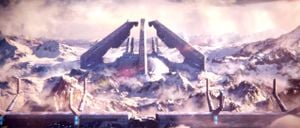
Forerunner architecture incorporates heavy use of geometric angles, usually at either extremely sharp degrees - Forerunner buildings are usually trapezoidal - or at forty-five degree angles. Most Forerunner architecture is constructed with a special type of silver-gray metal that resists deterioration, bullets, plasma bolts and fire, as made evident by Forerunner structures standing in pristine condition 100,000 - 150,000 years after they were built. However, their resistance to heavy plasma fire is limited; concentrated plasma discharge is capable of destroying some Forerunner architecture.[192][38] Other structures and certain starships were built with a golden-bronze colored metal.
The Forerunners were also highly skilled at creating stone architecture. Typically, these buildings were built from a pale brown or tan stone.[72] These structures were more subject to wear and aging, but their architectural sophistication remains apparent after 100,000 years.[193][194] A particularly prominent example of intact Forerunner stone architecture could be found within Onyx's Zone 67, which contained a massive Forerunner city constructed entirely of polished chalcedonic quartz.[195] In some structures, such as the Forerunner complex beneath Reach's Menachite Mountain, patterns and symbols had been embedded in the rock itself by manipulating its mineral inclusions.[196] Most interestingly, certain Forerunner buildings incorporated "mutable" stonework: a stone Forerunner structure in Ontom, Sanghelios featured passages that could shift and change by literally reshaping the stone from which their walls were built.[72]
In addition to physical structures, a large portion of Forerunner architecture is actually composed of sophisticated hard light construction. Such architecture is often crafted in the likeness of corporeal matter, most commonly gray Forerunner metal. Hard light structures can form complex shapes and in many cases, be entirely indistinguishable from physical construction,[197][198] making it difficult to determine which structural components are made up of actual matter.[74] This technology has many uses, from acting as basic structural components such as platforms or walls to decorating and furnishing everything from Forerunner homes and public spaces to starship interiors.[118] Many Forerunner structures are capable of materializing when needed and then melting away when deactivated, a feature most likely facilitated through the use of hard light. The immaterial and flexible nature of this technology lends it a great deal of uses, but as a drawback, it is susceptible to power failures;[199] nonetheless, certain Forerunner ships, such as the command warship Mantle's Approach, employ hard light bonding as a means of maintaining the vessel's structural integrity.[165] Some Forerunner structures, including many of those on Requiem, incorporate components which float in the air without any physical support.[74]
Many symbols and patterns on Forerunner structures employ complex geometric shapes that appear to operate in dimensions higher than human understanding can comprehend.[188] The Forerunners also decorated the interiors of their structures with a complex pattern of engraved straight lines and applied decorative touches and designs to nearly everything that they built, from structures to weapons. Even Sentinel drones possess small holographic Forerunner script around their "eyes".[71] Some Forerunner structures, most prominently those on Requiem, mark bullet holes and other forms of weapon strike points with a small glyph automatically etched around the damaged portion of the surface within moments of the impact.[74]
The Forerunners were highly skilled at creating natural-looking habitats, such as those of the Halo installations, which tend to be very elaborate and include realistic weather patterns and self-sustaining biomes. Although they are clearly distinct from the natural landscape, Forerunner structures often appear to "grow" out of the surrounding terrain, resulting in an impression of complementing the landscape as opposed to replacing it.[200]
Astroengineering[edit]
- Main article: Astroengineering
While the Forerunners' architectural and technological prowess is legendary, their masterpieces also extended to the fields of stellar and planetary engineering.
Shield World 006, a full-size Dyson shell, existed in slipstream space, where planets and stars cannot ordinarily exist. In addition, the slipspace bubble containing the enormous construct was enclosed within Onyx, a planet-sized structure composed of trillions of Sentinels arranged into a complex structural scaffolding and covered by a terrestrial crust. The Forerunners also created many smaller shield worlds, essentially planet-sized Dyson shells with terrestrial inner and outer surfaces as well a miniaturized sun in the center. Some works of Forerunner engineering are also located beyond the confines of the galaxy, including Installation 00, a vast, flower-shaped construct with a terrestrial surface and its own artificial star for illumination. Another example of the Forerunners' mastery of megascale engineering was the Capital, a structure which surpassed even the Ark in sheer enormity and complexity.[201]
In addition to moving and manipulating stars for use in their megastructures, Forerunner Miners, specifically stellar-class engineers known colloquially as "plasma jockeys", experimented with stabilizing young stars.[202] The Forerunners had also harnessed dozens of stars for energy production by using sophisticated energy fields to direct the energy output of a star.[148] Specialized plasma jockey installations were also capable of suspending the collapse of a star, although this was rarely entertained due to the enormous amounts of energy required in the process.[203] In addition to stellar manipulation, the Forerunners were capable of considerably speeding up a planet's formation, artificially collapsing an asteroid field into a molten mass, then cooling it down and forming it into a terrestrial planet in less than ten thousand years; a relatively short period of time for the ageless Forerunners.[202]
Production notes[edit]
| Language | Equivalent |
|---|---|
French |
Le Forerunner, only the first mention in Halo: Combat Evolved. Les Forerunners in almost all media. |

|
Browse more images in this article's gallery page. |
- According to Bungie employee David Candland,[204] Bungie's original intention for the connection between humanity and Forerunners was that they were one and the same; this was hinted repeatedly throughout the Halo Trilogy[205] and alluded to in Joseph Staten's novel Halo: Contact Harvest. During the development of Halo 3, Bungie was internally split on the relationship of humans and Forerunners. This has been described as there having been a "Game" team, and a "Terminals" team.[206] The "Game" team seemed to continue the original intention, as certain dialogue from Halo 3's story would imply,[207] while the "Terminals" team added the idea that Forerunners were a "…subset of early humans uplifted by another group (the precursors?)."[208]This is echoed in Halo 3's terminals, and also material released as part of the game's marketing campaign, but such materials do not explicitly comment on the connection between Forerunners and humanity. Because Bungie management were more focused on getting the game finished than canon,[206] the game shipped with both versions and both were approved.[209]
- The Halo: Evolutions story Soma the Painter first confirmed the two species were separate species and afterwards the books of The Forerunner Saga released by 343 Industries expanded greatly on the similarities and difference between both peoples, establishing that the two species were indeed related but distinct and that the actual connection goes far further back than the events in the books, to the time when both species had been created by the Precursors.
- In Titan, the canceled Halo MMO, the Forerunners were depicted as humans with dark skin and white hair, similar to the Atlanteans from Disney's Atlantis: The Lost Empire. This interspecies resemblance is likely based on Bungie's original intention of the Forerunners being ancient humans.[210]
- The Forerunners fill a similar narrative role to the Jjaro from Bungie's Marathon trilogy. The Jjaro likewise vanished eons ago but left behind technology which is reverse-engineered by the Pfhor, the primary antagonists of the series and spiritual predecessors to the Covenant. The plot of the third game, Marathon Infinity, involves the escape of a cosmic entity known as the W'rkncacnter through the Pfhor's misuse of an ancient Jjaro superweapon, similar to the Flood's release by the Covenant on Installation 04. The protagonist is effectively an undead cyborg reanimated and augmented through the use of Jjaro technology which enables him to interface with other Jjaro technology, much as the Spartan-IIs were created due to a geas which enables them to use Forerunner technology.
- Bungie environment artist Paul Russel was largely responsible for establishing the Forerunners' architecture and aesthetic. He cited some of his influences as being sails and movie marquees, as well as the works of American architect Frank Lloyd Wright;[211] in particular, Wright's use of cantilevers and stained glass windows with repeating geometric patterns of lines in complementary angles. Russel jokingly stated that "I also like the idea of Forerunner columns being sausages meticulously and gorgeously wrapped in bacon by Frank Lloyd Wright's genetic precursor. Now that is a tall tale. Because as far as I know, Forerunner architecture is inedible—unless the fans say otherwise."[212]
Gallery[edit]
A hologram of the Silent Cartographer facility on Installation 04 in Halo: Combat Evolved.
Installation 08's control room.
Bungie concept art of a Promethean combat skin, later reused for the design of a Prefect's armor.
Concept art made by Ensemble Studios for Titan of a Forerunner city in its prime.
A Forerunner Combat Skin, as seen in Origins.
A group of Forerunner military leaders within the Control Room of a Halo Installation.
A Forerunner activating a console, showing a remarkable similarity to a human hand. Note that this depiction may not be accurate.[213]
A Lifeworker facing a Monitor in Halo: Combat Evolved Anniversary's terminals.
Two Forerunner Lifeworkers in Halo 4's terminals.
Forerunner ships in Halo Mythos.
Forerunner technology in Halo: The Television Series Season One.
A dead Forerunner scientist in Halo: The Television Series Season Two.
List of appearances[edit]
Notes[edit]
- ^ It is never directly stated that the Forerunners' armor granted them truly indefinite lifespans, although this can be inferred from several statements in The Forerunner Saga. In Halo: Cryptum, Bornstellar notes that Forerunners died only on rare occasions, usually by accident or during war (Cryptum, page 47). In Halo: Silentium, the Librarian mentions having visited the collection of a former Theoretical on Keth Sidon (Silentium, page 67); since the Theoretical rate was dissolved a million years earlier, the former Theoretical would have been at least a million years old at the time, although it is not explicitly stated that the Theoretical in question was still alive.
Nonetheless, Halo 4: The Essential Visual Guide asserts that the Composers were originally designed to transfer old essences into youthful bodies. While this may seem rather trivial given the Forerunners' effective immortality, it is known that older members of the species (such as the Confirmer) could become significantly disfigured with age. The Composer entry on Halo Waypoint reiterates The Essential Visual Guide's statement and further reveals that composed essences may have been integrated into the Domain, granting them true permanence. - ^ In Halo: Silentium and subsequent media, the words comprising Forerunner names are joined by hyphens, whereas in Halo: Cryptum and Halo: Primordium, they are separated with spaces.
Sources[edit]
- ^ a b c d e f g h Halo Waypoint - Universe: Forerunners
- ^ a b c d e f g h i j k l Halo Encyclopedia (2022 edition), page 318-323
- ^ Halo: Cryptum, page 9
- ^ Halo: Cryptum, Epilogue
- ^ Halo: Cryptum, page 31
- ^ a b Halo Encyclopedia (2022 edition), page 310
- ^ Halo: Cryptum, page 222
- ^ Halo Mythos, page 7
- ^ Halo Mythos, page 7
- ^ a b Halo: Silentium, page 209
- ^ Halo: Primordium, page 194: "Long ago, when it became apparent that the Precursors were about to erase Forerunners, there was a war, and Forerunners erased them."
- ^ Halo: Silentium: String 10
- ^ Halo: Silentium: String 11
- ^ Halo: Silentium: String 15
- ^ Halo: Cryptum, page 203
- ^ Halo: Silentium, page 67-68
- ^ a b Halo Encyclopedia (2022 edition), page 312
- ^ a b c d Halo: Silentium, page 104-105
- ^ Halo: Silentium, page 119
- ^ Halo Encyclopedia (2009 edition), page 26
- ^ Halo: Cryptum, page 20
- ^ Halo: Cryptum, page 296
- ^ a b c d Halo: Epitaph, chapter 11
- ^ Halo: Silentium, page 246
- ^ a b Halo: Cryptum, page 25
- ^ Halo: Cryptum, page 112
- ^ Halo: Cryptum, page 130
- ^ a b Halo: Cryptum, page 267-273
- ^ Halo: Cryptum, page 127
- ^ Halo: Cryptum, page 188
- ^ a b Halo: Combat Evolved, campaign level Two Betrayals
- ^ Halo: Cryptum, page 237-238
- ^ a b c d e Halo 3: Terminals
- ^ Halo Encyclopedia (2009 edition), page 169
- ^ Halo Encyclopedia (2009 edition), page 172
- ^ Halo: Silentium, page 190
- ^ a b Halo: Silentium, page 214-215
- ^ a b Halo 2, campaign level The Great Journey
- ^ a b Halo Legends - Origins
- ^ a b Halo: Silentium, page 322-323
- ^ a b c d e Halo: Silentium: Rebirth
- ^ Halo: Silentium, page 314
- ^ a b c Halo: Fractures - Promises to Keep
- ^ Halo Encyclopedia (2022 edition), page 486
- ^ Halo Encyclopedia (2022 edition), page 25
- ^ Halo: Fractures - Untitled story
- ^ Halo: Silentium, page 323-325
- ^ Halo 4, campaign level Reclaimer
- ^ a b Halo: Renegades
- ^ a b c Halo: Contact Harvest
- ^ Halo: Contact Harvest, page 146-147
- ^ Halo: Evolutions - Wages of Sin
- ^ Halo 2, campaign level Sacred Icon
- ^ Halo 2
- ^ Halo: The Fall of Reach, page 275
- ^ Halo: First Strike, page 87
- ^ Halo: Primordium, page 375
- ^ Halo: The Flood, page 84
- ^ Halo: The Flood, page 146
- ^ Halo: The Flood, page 170
- ^ Halo: First Strike, page 142
- ^ Halo: Ghosts of Onyx, page 122-127
- ^ Halo: First Strike, page 108
- ^ Halo: The Essential Visual Guide, page 132
- ^ Halo: The Fall of Reach, chapter 25
- ^ Halo Wars, campaign level Reactor
- ^ Halo Wars, campaign level Escape
- ^ Halo: Evolutions - Dirt
- ^ Halo: Combat Evolved, campaign level The Pillar of Autumn
- ^ Halo: Reach, campaign level The Package
- ^ a b Halo 3
- ^ a b c Halo: The Thursday War
- ^ Halo: Escalation, issue 10
- ^ a b c d e f g h i j k Halo 4
- ^ Halo: Point of Light, chapter 41
- ^ Halo: Epitaph, chapter 5
- ^ Halo: Epitaph, chapter 9
- ^ Halo: Epitaph, chapter 22
- ^ Halo: Epitaph, chapter 20
- ^ a b c Halo: Epitaph, chapter 25
- ^ a b c Halo: Epitaph, chapter 26
- ^ a b Halo: Epitaph, chapter 27
- ^ a b c d Halo: Cryptum, page 47-48
- ^ a b Halo: Primordium, page 33-34
- ^ Halo: Cryptum, page 28
- ^ Halo: Silentium, page 89
- ^ Halo: Cryptum, page 26
- ^ Halo: Point of Light, page 18
- ^ a b Halo 4: The Essential Visual Guide, page 16
- ^ Halo: Cryptum, page 224-225
- ^ Halo 4: The Essential Visual Guide, page 17
- ^ a b Halo: Silentium, page 141
- ^ Halo: Primordium, page 339
- ^ Halo: Silentium, page 83
- ^ Halo: Primordium, page 166
- ^ Halo: Cryptum, page 338
- ^ Halo: Cryptum, page 209
- ^ Halo: Silentium, page 247
- ^ a b Halo: Cryptum, page 241
- ^ Halo: Silentium, page 150
- ^ Halo: Silentium, page 63
- ^ Halo: Silentium, page 161
- ^ Halo: Cryptum, page 140
- ^ Halo: Silentium, page 24
- ^ Halo: Cryptum, page 162
- ^ Halo: Cryptum, page 316
- ^ Halo: Cryptum, page 319
- ^ Halo: Silentium, page 82-83
- ^ a b Halo: Cryptum, page 225
- ^ Halo: Cryptum, page 167-168
- ^ Halo: Cryptum, page 146
- ^ Halo: Cryptum, page 178
- ^ Halo: Cryptum, page 112-113
- ^ Halo: Cryptum, page 126-127
- ^ Halo: Primordium, page 156
- ^ Halo: Cryptum, chapter 2
- ^ Halo: Silentium, page 14
- ^ a b Halo: Cryptum, page 242
- ^ Halo: Silentium, page 255
- ^ Halo: Silentium, page 275
- ^ Halo: Silentium, page 241-242
- ^ a b Halo: Epitaph, chapter 14
- ^ Halo: Cryptum, page 88
- ^ Halo: Cryptum, page 99
- ^ Halo: Cryptum, page 153
- ^ a b Halo: Evolutions - Soma the Painter
- ^ Halo: Cryptum, page 292
- ^ Halo: Cryptum, page 255
- ^ Halo: Cryptum, page 264
- ^ Halo Waypoint, Cryptum Glossary (Retrieved on Mar 14, 2014) [local archive] [external archive]
- ^ Halo: Cryptum, page 37
- ^ Halo: Cryptum, page 77
- ^ Halo: Cryptum, page 231-232
- ^ Halo: Silentium, page 251
- ^ Halo: Cryptum, page 224
- ^ a b Halo: Cryptum, page 227
- ^ Halo: First Strike, page 142
- ^ Halo: First Strike, page 197
- ^ Halo: Cryptum, page 261
- ^ Halo: Cryptum, page 227-228
- ^ Halo: Cryptum, page 33
- ^ Halo: Cryptum, page 283
- ^ a b Halo: Cryptum, page 129
- ^ Halo: Combat Evolved
- ^ Halo: Cryptum, page 98
- ^ Halo: Silentium, page 113
- ^ Halo: Cryptum, page 304
- ^ a b Halo: Cryptum, page 243
- ^ Halo: Cryptum, page 254
- ^ a b Halo: Cryptum, page 100
- ^ Halo: Silentium, page 131
- ^ Halo: Silentium, page 279
- ^ Halo: Ghosts of Onyx, page 182-183
- ^ Halo: Primordium, page 366
- ^ Halo: Silentium, page 211
- ^ Halo: Blood Line
- ^ Halo: Cryptum, page 106
- ^ Halo: Silentium, page 324
- ^ Halo: Ghosts of Onyx, page 316
- ^ a b Halo: Cryptum, page 124
- ^ Halo: Cryptum, page 19-20
- ^ Halo: Cryptum, page 200
- ^ Halo: Cryptum, page 114
- ^ Halo: Cryptum, page 312
- ^ a b Halo 4: The Essential Visual Guide, page 193
- ^ Halo: Cryptum, page 125
- ^ Halo: Cryptum, page 144
- ^ Halo: Fractures - Defender of the Storm
- ^ Halo: Combat Evolved Anniversary: Terminal 4
- ^ Halo: Cryptum, page 136
- ^ Halo: Silentium, page 121
- ^ Halo: Cryptum, page 43
- ^ Halo: Silentium, page 273
- ^ Halo: Silentium, page 213
- ^ Halo: Silentium, page 297
- ^ Halo: Silentium, page 20
- ^ Halo: Primordium, page 356-357
- ^ Bestiarum: "DNA/RNA/Silicon samples are encoded in this data stream. Reproduction of individuals for analysis is prohibited by this facility."
- ^ Halo: Silentium, page 57
- ^ Halo: Cryptum, page 55
- ^ Halo: Silentium, page 40
- ^ Halo: Silentium, page 256
- ^ Halo: Silentium, page 55
- ^ Halo: Silentium, page 322
- ^ Halo: Epitaph, chapter 10
- ^ Halo 4: The Essential Visual Guide, page 101
- ^ Halo Waypoint: Canon Fodder - Under Locke & Keynote
- ^ a b Halo: Ghosts of Onyx
- ^ Halo 3, campaign level Floodgate
- ^ Halo 3, campaign level Halo
- ^ Halo Waypoint: Canon Fodder - Uncharted Waters
- ^ Halo: Ghosts of Onyx, page ???
- ^ Halo 3: multiplayer map Sandtrap
- ^ Halo 2, campaign level Delta Halo
- ^ Halo: Ghosts of Onyx, page 269
- ^ Halo: First Strike, page 139
- ^ Halo: Primordium, page 116
- ^ Halo: Primordium, page 201
- ^ Halo: Primordium, page 50
- ^ The Art of Halo, page 90
- ^ Halo: Cryptum, page 280-281
- ^ a b Halo: Cryptum, page 221
- ^ Halo 4: multiplayer map Solace (map description)
- ^ halo.bungie.org: Re: Why retcons don't bother me anymore (Evil Otto: "One of the most striking retcons to me is the basic concept of whole role of humanity. Originally (back in Halo 1) the reason why humans weren't conquered and incorporated into the Covenant collective was because their presence defied Covenant religion. When the Covenant discovered humans, they knew they were forerunners, but their presence implied the "great journey" failed. They also weren't the all powerful gods they worshiped, so the Prophets wanted to "sweep them under the carpet," as it were.")
- ^ halo.bungie.org: Re: Why retcons don't bother me anymore (Evil Otto: "The plot lines in our games imply this everywhere - the chief being called reclaimer, only humans being able to retrieve and insert the index, Spark telling the chief, "you are forerunner." etc.")
- ^ a b Twitter, Paul Russel (@docabominable): "From what I have gathered by talking to people involved offline: The game and terminal writers were separate teams with overlap; they didn't think the discrepancy would matter; management vetting never read or cared about continuity..." (Retrieved on Dec 18, 2022) [archive]
- ^ Twitter, Paul Russel (@docabominable): "The way I understand it is that the terminal version is the same but adds the precursor angle of selecting a subset of humans to advance." (Retrieved on Dec 14, 2022) [archive]
- ^ Twitter, Paul Russel (@docabominable): "One of the writers said that the (terminal) forerunners were a '…subset of early humans uplifted by another group (the precursors?)'. Also 'I don’t believe that management gave a single shit about any story element...they only cared about shipping a game.'" (Retrieved on Dec 18, 2022) [archive]
- ^ Twitter, Paul Russel (@docabominable): "I hoped that came across as MAYBE the discrepancy came up and didn’t seem important against everything happening to get a AAA game out the door. I’m trying to be careful to not put words in others mouths. One thing for sure, H3 shipped with both versions and both were approved." (Retrieved on Dec 13, 2022) [archive]
- ^ Halo Heaven Gallery: Concept Art - Forerunner
- ^ Paul Russel's image album
- ^ Halo: The Art of Building Worlds, page 28
- ^ Halo Legends: Origins: Commentary: Frank O'Connor: "This is a bit of a trick, you see? Cortana doesn't actually know what they look like, so their appearance may be further explored in future Halo canon.
External links[edit]
- Forerunner Symbolism: An article on Forerunner symbols
- A comprehensive research over the Forerunners.
| |||||||||||||||||||||||||
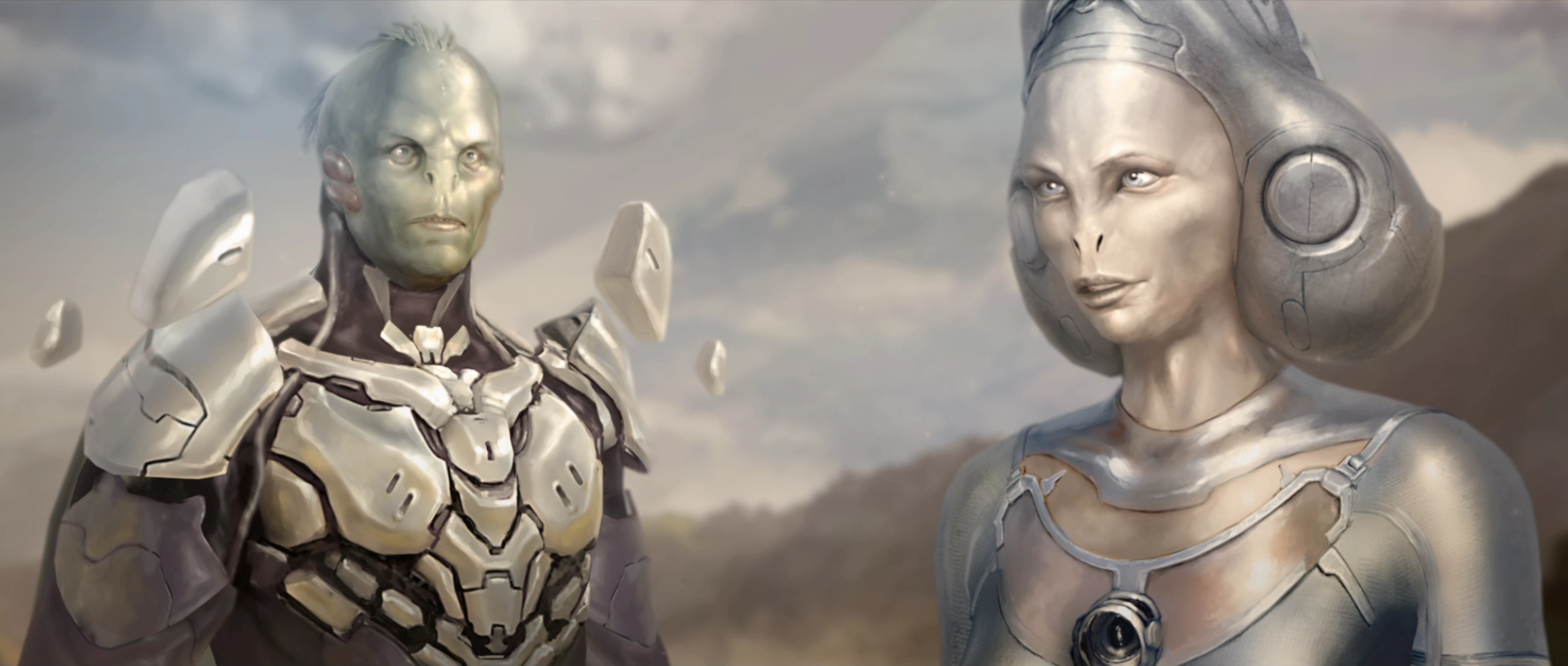


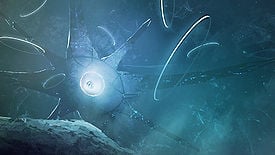
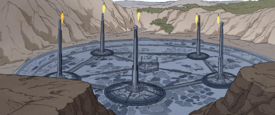

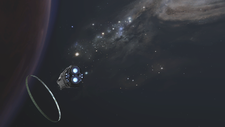
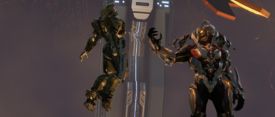
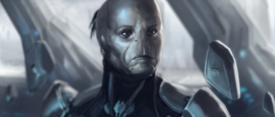


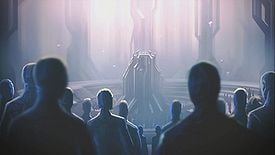



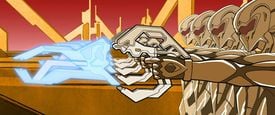

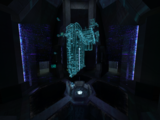
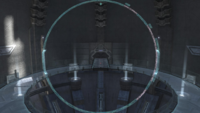

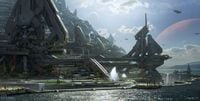


![A Forerunner activating a console, showing a remarkable similarity to a human hand. Note that this depiction may not be accurate.[213]](https://halo.wiki.gallery/images/thumb/f/f5/Forerunner_Apex.jpg/200px-Forerunner_Apex.jpg)

